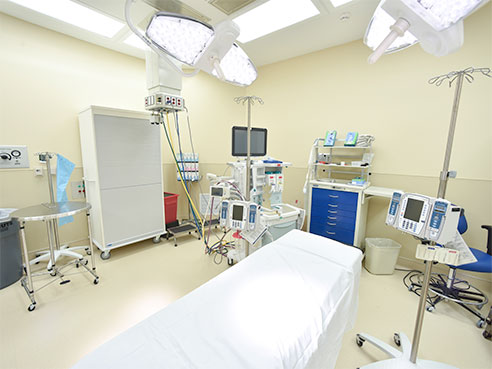 The AOC moved into its new 8,710-square-foot office space in 2015. The facility includes two ICU bays, two organ and tissue recovery suites, and lab services.
The AOC moved into its new 8,710-square-foot office space in 2015. The facility includes two ICU bays, two organ and tissue recovery suites, and lab services.
In an effort to increase the number of organs recovered for transplant and in turn save more lives, the Alabama Organ Center announced today the opening of its new Donor Recovery Center, located at 502 20th Street South.
The addition of the Donor Recovery Center, announced as part of National Donate Life Month, makes the AOC one of only eight procurement organizations in the country to have an in-house recovery center. It is also the only one connected to an academic medical center the size of the University of Alabama at Birmingham.
“This is a great achievement for the people of the state of Alabama, especially those who are registered to be organ donors and those who are in need of a transplant,” said Chris Meeks, executive director of the AOC. “We believe the potential to save more lives through organ donation will be increased with the new recovery center.”
The Donor Recovery Center began receiving tissue donors in December 2015 and began transferring organ donors in February of this year.
Devin Eckhoff, M.D., director of UAB’s Division of Transplantation in the School of Medicine and medical director of the AOC, says the addition of the recovery center will increase the number of suitable organs available for transplants and provide for more efficient care for patients.
“We always say organ donors are true heroes because they make a conscious decision to enrich the lives of others upon their death,” Eckhoff said. “The Donor Recovery Center will enable physicians to create a tight network that can administer more consistent and protocoled care, which will translate into organs more suitable for transplant. It ensures their gifts are maximized in our efforts to help others reach transplant.”
Last Friday, President Obama marked the beginning of National Donate Life Month with a proclamation that underscored the importance of working across sectors to “do our part to lift up donors, donor families, and patients by supporting efforts to shorten the organ waiting list.”
As a part of the Federal Government’s efforts senior Administration officials will host a White House summit in the coming months to highlight the role of innovation in organ donation and transplantation.
Recovery process
Brain death occurs due to irreversible loss of all brain function, which results from devastating conditions such as a traumatic brain injury or catastrophic stroke. When the brain stops functioning, mechanical support is necessary to provide oxygen to the vital organs to keep them transplantable, or viable, until organ removal can occur. Traditionally, when an organ donor is declared brain dead, the process of maintaining the health of the eligible donor’s vital organs until transplant surgeons are able to remove them occurs in the donor’s hospital.
 Bringing donors to the AOC recovery center will significantly decrease the total time from procurement to transplant, to almost in half, improving transplant outcomes. Transplant surgeons at UAB and AOC staff travel to hospitals throughout the state and beyond frequently to recover organs from deceased donors. Recovered organs are chilled and brought to the hospital where the transplant will occur. The length of time that passes during transport can potentially diminish the quality of the organs. Bringing donors to the AOC recovery center will significantly decrease the total time from procurement to transplant, to almost in half, improving transplant outcomes. The new facility will also lower the burden on donor hospital resources. Transferring donors to the AOC Donor Recovery Center will open much-needed ICU beds in the donor hospital and not require the use of their operating room.
Bringing donors to the AOC recovery center will significantly decrease the total time from procurement to transplant, to almost in half, improving transplant outcomes. Transplant surgeons at UAB and AOC staff travel to hospitals throughout the state and beyond frequently to recover organs from deceased donors. Recovered organs are chilled and brought to the hospital where the transplant will occur. The length of time that passes during transport can potentially diminish the quality of the organs. Bringing donors to the AOC recovery center will significantly decrease the total time from procurement to transplant, to almost in half, improving transplant outcomes. The new facility will also lower the burden on donor hospital resources. Transferring donors to the AOC Donor Recovery Center will open much-needed ICU beds in the donor hospital and not require the use of their operating room.
Deceased organ donation requires a person to be in a hospital and on a ventilator when he or she is pronounced brain dead. The manner in which a person dies determines what organs and tissues can be donated. In most cases, people who are evaluated for organ donation have suffered fatal head injuries resulting from a car accident, stroke or brain aneurysm.
As part of the new recovery center process, the AOC will, with the donor family’s permission, transport their deceased loved one to the recovery center at no financial cost to the family.
The organ and tissue evaluation and recovery will then be performed at the recovery center. Afterward, the donor will be transported to the funeral home of the family’s choosing or to the state medical examiner for an autopsy if necessary.
A recent paper published in the Journal of the American College of Surgeons focused on a study that evaluated six years of data from the nation’s first standalone organ recovery facility, located in St. Louis and owned and operated by Mid-America Transplant. The study authors say organ recovery at a standalone facility is innovative, more efficient, leads to a higher number of transplantable organs recovered when brain dead donors are moved to dedicated organ recovery facilities, and reduces costs associated with current methods of procurement. This includes hospital operating room costs and physician travel to procure organs, which can occur at all hours of the day and night.
The paper showed donor management and organ recovery performed at an independent facility reportedly cost organ procurement organizations half as much as what they paid hospitals in recovery costs for donors kept at the hospital.
The AOC moved into its new 8,710-square-foot office space in 2015. The facility includes two ICU bays, two organ and tissue recovery suites, and lab services. Specially trained critical care nurses are responsible for donor management and have access to a critical care physician or medical director for consultation as needed.
Sign up today to be an organ donor at alabamaorgancenter.org.